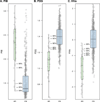An operational approach to National Institute on Aging-Alzheimer's Association criteria for preclinical Alzheimer disease
- PMID: 22488240
- PMCID: PMC3586223
- DOI: 10.1002/ana.22628
An operational approach to National Institute on Aging-Alzheimer's Association criteria for preclinical Alzheimer disease
Abstract
Objective: A workgroup commissioned by the Alzheimer's Association (AA) and the National Institute on Aging (NIA) recently published research criteria for preclinical Alzheimer disease (AD). We performed a preliminary assessment of these guidelines.
Methods: We employed Pittsburgh compound B positron emission tomography (PET) imaging as our biomarker of cerebral amyloidosis, and (18) fluorodeoxyglucose PET imaging and hippocampal volume as biomarkers of neurodegeneration. A group of 42 clinically diagnosed AD subjects was used to create imaging biomarker cutpoints. A group of 450 cognitively normal (CN) subjects from a population-based sample was used to develop cognitive cutpoints and to assess population frequencies of the different preclinical AD stages using different cutpoint criteria.
Results: The new criteria subdivide the preclinical phase of AD into stages 1 to 3. To classify our CN subjects, 2 additional categories were needed. Stage 0 denotes subjects with normal AD biomarkers and no evidence of subtle cognitive impairment. Suspected non-AD pathophysiology (SNAP) denotes subjects with normal amyloid PET imaging, but abnormal neurodegeneration biomarker studies. At fixed cutpoints corresponding to 90% sensitivity for diagnosing AD and the 10th percentile of CN cognitive scores, 43% of our sample was classified as stage 0, 16% stage 1, 12 % stage 2, 3% stage 3, and 23% SNAP.
Interpretation: This cross-sectional evaluation of the NIA-AA criteria for preclinical AD indicates that the 1-3 staging criteria coupled with stage 0 and SNAP categories classify 97% of CN subjects from a population-based sample, leaving only 3% unclassified. Future longitudinal validation of the criteria will be important.
Copyright © 2012 American Neurological Association.
Figures





References
-
- Ingelsson M, et al. Early Abeta accumulation and progressive synaptic loss, gliosis, and tangle formation in AD brain. Neurology. 2004;62(6):925–931. - PubMed
Publication types
MeSH terms
Substances
Grants and funding
LinkOut - more resources
Full Text Sources
Other Literature Sources
Medical

